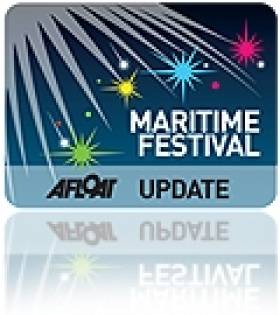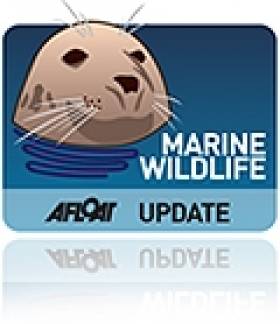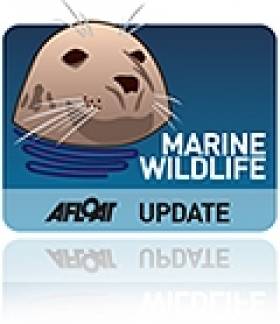Displaying items by tag: Seabirds
Stakeholder Consultation on Restricted Activities Under Proposed SPA for Seabirds in North-West Irish Sea
The Minister for Housing, Local Government and Heritage has issued a direction regarding activities requiring prior ministerial approval within the site of the proposed special protection area (SPA) for seabirds in the North-West Irish Sea.
As reported earlier this year on Afloat.ie, the proposed new SPA will cover over 230,000 hectares extending out from Dublin Bay to as far north as Dunany Point in Co Louth, and will increase Ireland’s percentage of marine waters protected under the EU Birds and Habitats directive to over nine per cent.
The list of Activities Requiring Consent relating to the SPA includes the following:
- Reclamation, including infilling.
- Blasting, drilling, dredging or otherwise removing or disturbing fossils, rock, minerals, mud, sand, gravel or other sediment.
- Introduction, or re-introduction, of plants or animals not found in the area. (Consent is not required for the planting of crops on established reseeded grassland or cultivated land.)
- Undertaking scientific research involving the collection and removal of biological material.
- Any activity intended to disturb birds, including by mechanical, air, gas, wind-powered or audible means.
- Developing or consenting to the development or operation of commercial recreational/visitor facilities or organised recreational activities.
- Undertaking active acoustic surveys in the marine environment.
Observations in relation to the classification of the site may be submitted by interested parties and must be supported by scientifically based ornithological criteria.
Any objections to the classification of the site as a SPA or the Ministerial Direction may be lodged with the National Parks and Wildlife service.
The closing date for receipt of any observations or objections is 19 February 2024 and further details are included in Marine Notice No 80 of 2023, attache below.
Birdwatch Ireland Expresses Alarm at Avian Flu Spread in Seabirds and Calls for Urgent Response Plan from Government
BirdWatch Ireland has said it is “shocked” at the spread of a highly virulent strain of avian flu in seabird colonies in Britain, and says Ireland needs to develop a response plan urgently.
No cases of highly pathogenic avian influenza (HPAI) have been positively identified in seabirds in the Republic of Ireland yet, but cases have been confirmed in several locations in Northern Ireland, it says.
The NGO is calling on the government to convene key stakeholders “urgently” with a view to developing and implementing a response plan to the growing threat of the spread in Ireland.
“We are witnessing the potential decimation of seabird populations on a scale that has not been seen before in our lifetimes. We are as a result gravely concerned for seabird colonies in Ireland,”Birdwatch Ireland says.
“We believe that it is only a matter of time before a wild bird is tested positive by Department of Agriculture, Food and Marine veterinary staff, but casual sightings indicate that the disease is probably present in our wild birds already,” it says.
“HPAI has the potential to spread rapidly in breeding seabird colonies, as seabirds gather in high numbers and in close proximity to lay eggs and rear chicks on Irish cliffs, headlands and islands,”it says.
Birdwatch Ireland stresses the international importance of Irish colonies, with Rockabill Island off the coast of Skerries in north County Dublin holding up to 80% of Europe’s breeding Roseate Terns.
The Kilcoole, County Wicklow Little Tern colony holds 40% of Ireland’s Little Tern population, it says, while Manx Shearwater occurs on just a handful of colonies.
Sites off the south-east such as Great Saltee island hold internationally important breeding seabird populations, including the gannet, which has been impacted particularly severely, it says.
It says that given that 23 of Ireland’s 24 breeding seabirds are already red or amber listed birds of conservation concern, with global threats to the puffin and kittiwake, the government here must act very quickly and take the HPAI threat seriously.
Birdwatch Ireland senior seabird conservation officer Dr Stephen Newton described the situation as “frightening”.
“There are three or four species where virtually the whole of the Irish, or sometimes the whole of the European, population nest at just one or two sites. Our big fear is that these could be wiped out completely,” Dr Newton says.
BirdWatch Ireland says that with the agreement of the National Parks and Wildlife Service it is ceasing research and monitoring activities at seabird colonies, where staff and volunteers would be in very close proximity to wild birds, except in exceptional circumstances.
“ This will help reduce disturbance and minimise the risk of spreading the disease,”it says.
“Our seabirds are the life and soul of the coastline in the summer. The Irish Government has a responsibility to protect them as much as possible from this deadly disease,”it says.
“HPAI originated in intensively manged poultry flocks and then infected wild birds. Putting in place measures which may help to minimise the spread in Ireland is essential to prevent further biodiversity loss, but also to protect poultry flocks which could be re-infected from the disease circulating in the wild bird population,”it says.
It advises anyone who sees a dead or distressed wild bird to report it to the Department of Agriculture, Fisheries and the Marine at https://aviancheck.apps.rhos.agriculture.gov.ie/report.
Sailors & Seabirds
Seabirds and sailors have a long history together. They are reputed to have guided lost sailors to land, led fishermen to catch fish and the sight of them has encouraged many a despairing sailor to realise that land is nearby. From the time a small bird, obviously tired, came out of nowhere to land on NCB Ireland when I was crewing aboard in the then Whitbread Round the World Race, I have been fascinated by how birds fly huge distances over the oceans. That bird stayed for over a day and we were anxious to feed and give it water. Then, sometime in the early dawn it left, heading for I know not where. The legendary Albatross is perhaps the most well-known bird of the seas. Whenever I am sailing in Cork Harbour and see birds dive out of the sky, plunging into and below the water to catch fish, I watch fascinated. When seagulls were being accused of attacking humans in their search for food, it was tme a sign of food lacking at sea as they came inland.
Birdwatch Ireland is the organisation which protects Ireland's birds and their habitats. Fintan Kelly, Policy Officer at Birdwatch, told me this week on the podcast below that one of the most troubling indications of the state of the broader marine environment comes from research carried out on the behaviour of seabirds, because they are excellent indicators of what is happening at and in the sea.
As I said at the outset, seabirds and humans have a long history together, but many species of seabirds are threatened by human activities, which all of us sailors should be concerned about. So I urge you to listen to what Fintan Kelly has to say. You might just think a lot more about the next birds you encounter at sea.
Listen to him on the podcast below where you can also hear how Lifeguards prevented 16,316 marine accidents and keep up with the pace of life on the offshore islands which is quite hectic.
Tom MacSweeney presents This Island Nation maritime programme
#MaritimeFestivals - The inaugural Cliffs of Moher Seabirds Festival will take place from 9 to 14 May at the famous Clare coastal attraction and in other locations around the Burren and Cliffs of Moher Geopark.
Over 60,000 seabirds can be seen at the Cliffs of Moher during the breeding season, including puffins, guillemots, razorbills, kittiwake and fulmar nesting a different levels of the cliffs.
The cliffs are a Special Protected Area for seabirds and are also home to other bird species such as peregrine falcons, choughs and ravens.
There is nowhere else on the mainland of Ireland where you can so easily see such a host of nesting seabirds from accessible viewing points on the grounds of the Cliffs of Moher Visitor Experience or from the boat of the Cliffs of Moher cruises from Doolin.
The Cliffs of Moher Seabirds Festival aims to celebrate the presence of "our feathered fishy friends" with a programme of family-friendly activities including 'seabird bingo', guided birdwatching and flight demonstrations.
More details can be found HERE on the latest addition to Ireland's maritime festivals.
West Cork Weekends Will Bring You Closer To Marine Wildlife
#MarineWildlife - If you've ever wanted to get closer to Ireland's marine wildlife, a new series of weekend excursions in West Cork may be just the ticket.
The Southern Star reports on the 'Discover Wildlife Weekends' being run from Rosscarbery by local company Ireland's Wildlife starting this April, where those taking part will be led by expert guides to explore the coastal region and have the best opportunities to spot the many species of whales and dolphins that visit our shores.
Weather permitting, the weekends will also involve some offshore whale watching in the company of 'whale watch supremo' Colin Barnes and the Irish Whale and Dolphin Group's (IWDG) sightings co-ordinator Pádraig Whooley.
And birdwatching will also be a feature, as West Cork is a hotspot for our feathered friends - from merlins and peregrine falcons to coastal waders and more exotic fowl that skirt our coasts on their spring migrations.
The Southern Star has much more on the story HERE.
Meanwhile, marine sector stakeholders have expressed their concerns over the designation of six new offshore marine areas by the National Parks and Wildlife Service.
As previously reported on Afloat.ie, the six sites at Blackwater Bank in Wexford, the West Connacht coast, Hempton's Turbot Bank in Donegal, the Porcupine Bank Canyon off Kerry, the South-East Rockall Bank, and the stretch from Rockabill to Dalkey Island off Dublin have been proposed for designation as Special Areas of Conservation (SACs) to protect marine habitats and species listed on the 1992 EU Habitats Directive.
But at a recent meeting at the Irish Farm Centre in Dublin, a coalition of fish farmers, fishermen and marine energy stakeholders have hit out at what they characterise as "the appalling handling of inshore designations since the 1990s by the State", which they claim "has resulted in hundreds of job losses and a flight of serious investment" from Ireland's coastal areas.
“Our experience of the Irish Government’s application of the EU Habitats Directive has been a saga of mismanagement, foot dragging and buck-passing which has left over 500 fish farming licences in limbo for over 10 years and a backlog of red tape and bureaucracy which could see producers waiting until 2020 and beyond for simple renewals which are vital to underpin their businesses," said IFA aquaculture executive Richie Flynn.
"These new offshore SACs will have the same effect of preventing any fishing, marine energy or aquaculture being carried out in these areas if left in the hands of the same agencies to manage."
Dead Seals Washed Up at Fethard-on-Sea
#MARINE WILDLIFE - The Gorey Guardian reports that the bodies of two grey seals were found washed up last week on Booley Bay beach, near Fethard-on-Sea in Co Wexford.
The two seal pups were found in an emaciated and malnourished state by a beach walker on 27 November.
According to Irish Whale and Dolphin Group chair Kevin MacCormick, dead seal strandings are not unusual at this time of year, particularly after stormy weather, and grey seals have an especially high mortality rate.
Tramua wounds and blood found on the seals were put down to predation by seabirds.
Warning Over Oil Drill Threat to Rathlin Island Wildlife
Wildlife on Rathlin Island could be under threat if oil-drilling licences are awarded in the area, the Belfast Telegraph reports.
The north Antrim coast has been earmarked as a site for potential oil exploration in the latest round of British Government licensing, despite the area being designated as both a Special Protection Area and a Special Area of Conservation.
Environmental experts have warned of the devastating effect that oil drilling could have on marine wildlife on Rathlin Island and the nearby coastline.
"We've seen off the coast of Aberdeenshire that no matter how careful the drilling, there is always the risk of a spill," said Claire Ferry of the RSPB.
"In this case the spill happened far away from any vulnerable wildlife colonies, but just imagine the impact if that oil was washing onto a globally important seabird colony."
The Belfast Telegraph has more on the story HERE.
Up Close and Personal: New Boat Tours of Dublin Port
In addition to cruising this stretch of the River Liffey alongside the 'Docklands' quarter, the tour RIB boat will pass downriver through the East-Link toll bridge where visitors will get closer views of the variety of vessels and calling cruise liners from other ports throughout the world.
There will be five daily tours beginning at 10.00am, 12.00pm, 2.00pm, 4.00pm and 6.00pm.Tickets cost €15.00 for adults, €12.50 for students and the charge for senior citizens and children is €10.00.
In addition Sea Safari operate a 'River Liffey' only tour, a Dublin Bay 'North' and 'South' tours which visit Howth Head, Baily Lighthouse, Ireland's Eye and to Dalkey Island and Killiney Bay, where both bay tours provide a chance to spot local marine wildlife of seals, porpoises and sea birds.
- Rib
- Dublin Port
- Dublin Docklands
- Howth Head
- marine wildlife
- Cruise Liners
- Sea Safari Tours
- Dalkey Island
- Port of Dublin
- River Liffey
- Ports and Shipping News
- EastLink
- EastLink Toll Bridge
- Dublin Port news
- Baily Lighthouse
- Killiney Bay
- Seabirds
- Port of Dublin news
- RIBcraft
- M.V. Cill Airne
- Dublin Port cruise liners
- North Quay Wall Dublin
- Dublin Bay tours
- Ireland's Eye
Scientists Tracking Seabirds by GPS
A new EU-funded project is tracking the movements of seabirds along the Atlantic coastlines of Ireland, the UK, France, Spain and Portugal.
The Future of the Atlantic Marine Environment (FAME) project aims to pinpoint areas that are important for Europe's seabirds. This knowledge may assist in the selection of marine conservation areas to protect declining species.
According to Surfbirds News, the researchers are taping tiny GPS trackers to the backs of seabirds, allowing the scientists to accurately pinpoint their movements between the birds' nesting colonies and the areas of sea they use to find food.
"Up to now we've known very little about the movements of these birds when they venture out to sea to find food," said seabird scientist Dr Ellie Owen. "But now, just when these birds need our help, we're on the cusp of filling this information void with vitally-important data."
Surfbirds News has more on the story HERE.
Ferry Operator Assists in Marine-Life Conservation Role
Fastnet Line which runs the Cork-Swansea port route on the Celtic Sea, is assisting the charity MarineLife to monitor cetaceans, writes Jehan Ashmore.
The work of MarineLife is to survey the population trends and track the movements of dolphins, whales, porpoises and other wildlife. The research is undertaken onboard Fastnet Line's Julia (1981/21,699grt) and access to the ferry is provided free-of-charge to the wildlife-based charity.
During the months of July and August the ferry's schedule will allow for further opportunities to conduct daylight sightings of marine-life which is to be posted on MarineLife and Fastnet Line websites.
Adrian Shephard, Chairman of MarineLife Trustees, said: "The route from Swansea to Cork crosses a range of marine habitats and we hope it will generate many sightings of cetaceans and seabirds, including two important species we monitor, the white-beaked dolphin and the balearic shearwater".
In addition monitors recently observed fin whales, the second largest whale on the planet. Such sightings provide vital information and this will contribute to a better understanding of the distribution of cetaceans and other marine life in the Celtic Sea. To read more www.marine-life.org.uk
The first of four summertime surveys is to take place on 10 July. Overall the research by MarineLife is part of a larger project which also involves the use of other ferries operating in the Irish Sea and those serving on UK continental routes.
The 1,500 passenger / 325 car-carrying Julia sails year-round six times a week between September to June and from next month and during August the vessel will provide eight sailings per week. For fares and sailings schedules contact www.fastnetline.com





































































